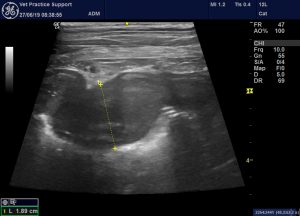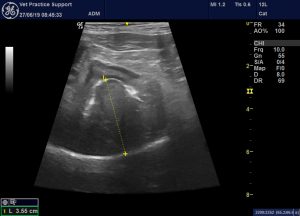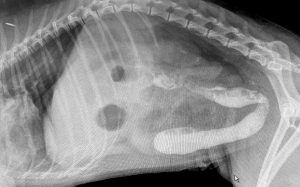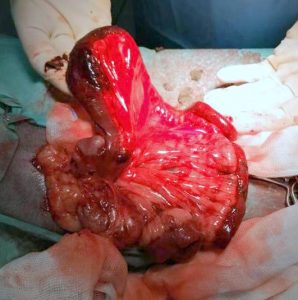Sand ingestion in three dogs: a cause of severe gastroenteritis (even without impaction)
Sand impaction has been described in a small number of dogs:
J Small Anim Pract. 2010 Jan;51(1):29-33
Sand impaction of the small intestine in eight dogs.
Moles AD1, McGhite A, Schaaf OR, Read R.
https://www.ncbi.nlm.nih.gov/pubmed/20137006
In all of those dogs, impaction in the ileum proximal to the ileo-caeco-colic junction was documented and thought to be the principal cause of signs; although the authors do allude to the additional potential for ‘direct mechanical insult to the mucosa of the gastrointestinal tract’.
Recently, we have seen three dogs with a history of known sand ingestion or playing with sandy toys on the beach in which severe non-obstructive gastroenteritis with apparent ulceration followed within 48 hours.
Case 1: a 7-year-old Labrador presented with a history of acute onset vomiting and haemorrhagic diarrhoea. Routine haematology and biochemistry proved unremarkable but vomiting continued over the following week becoming even more frequent and culminating in severe lethargy and anorexia.
On ultrasound the duodenal and pyloric mucosa were irregularly hyperechoic with the most convincing erosions close to the pylorus. The lumen of the pyloric antrum and the whole small intestine contained mobile ‘sludge’ of shadowing material. There was no evidence of intestinal obstruction.

An approximately transverse plane view of the pylorus from the right 11th intercostal space. The pyloric antrum contains some mobile particulate matter. The duodenal lumen contains a thick ‘sludge’ of shadowing material.

Further detail of the cranial duodenal flexure: the mucosal surface is hyperechoic and irregular consistent with ulceration.
On CT examination the presence of mineralised particulate material throughout the abdominal gastrointestinal tract was confirmed. No other cause of signs was identified. Upper GI endoscopy revealed sand/grit in the stomach lumen, diffuse erythema of the pyloric antrum/duodenum and small ulcers close to the pylorus.
Histopathological examination of endoscopic biopsies showed ‘mucosal ulceration and a neutrophilic and lymphocytic gastritis with particles of mineralised material within the ulcerations’.
She responded to symptomatic treatment and ultimately recovered fully but was only able to leave hospital 10 days after onset of signs.
Case 2: a 10-year-old Staffordshire Bull Terrier presented with a 3 day history of frequent vomiting (sometimes haematemesis), anorexia and haemorrhagic diarrhoea after playing with a sandy toy on the beach the preceding day.
On abdominal sonography there was no evidence of extra-intestinal pathology and no sign of gastrointestinal obstruction. However, the small intestinal lumen from the descending duodenum onwards contained mobile ‘drifts’ of shadowing particulate material.
This dog also recovered with supportive management and continued to pass sand in faeces for the following week.
Case 3: A 9 y.o. Cocker Spaniel presented with acute malaise, vomiting, haematochezia and melaena the day after playing on the beach and eating an unidentified sandy ‘object’ unearthed from the dunes. Her haematocrit was 30%. Routine blood biochemistry was unremarkable.
She remained lethargic and inappetent but otherwise stable until sonographic examination three days later. Again there was no evidence of GI obstruction and no abnormal findings outside the gut. The stomach wall was diffusely thickened and hypoechoic with indistinct layering and a hyperechoic mucosal surface.

transverse plane view of the greater curvature wall of the stomach showing thickening and loss of normal layering.

sagittal plane view of the stomach showing marked asymmetrical wall thickening which is presumed to have been an acute gastritis: since she subsequently made a full recovery.
On endoscopy the gastric mucosa was diffusely erythematous with shallow erosions. Histopathology from endoscopic biopsies confirmed a mixed inflammatory infiltrate in the mucosa.
The patient made a full recovery with supportive treatment and remains well 8 months later.
The possibility than any of these cases might have been caused by an infectious or toxic agent cannot be excluded. However, circumstantial evidence suggests that the mechanical effect alone of sand may be enough to cause severe GI signs which may take many days to resolve. A history of exposure to sand or finding of mineralised particulate matter in the gut on imaging is worth considering as a potential cause of acute vomiting, haematemesis, gastritis, melaena or haematochezia.
Post-script:
A further case to add. Another young, otherwise healthy dog with a history of a visit to the beach followed by acute haemorrhagic vomiting and diarrhoea.

Again there is no evidence of complete GI obstruction. This patient deteriorated despite intensive medical care and eventually went to laparotomy.

Large areas of devitalised gut wall were present, the distal small intestine contained large amounts of sand. Ultimately euthanasia was necessary.





